10 tricks for landscaping with boulders: add drama to your plot
Our favorite ways of landscaping with boulders will introduce scale, texture and interest to your backyard
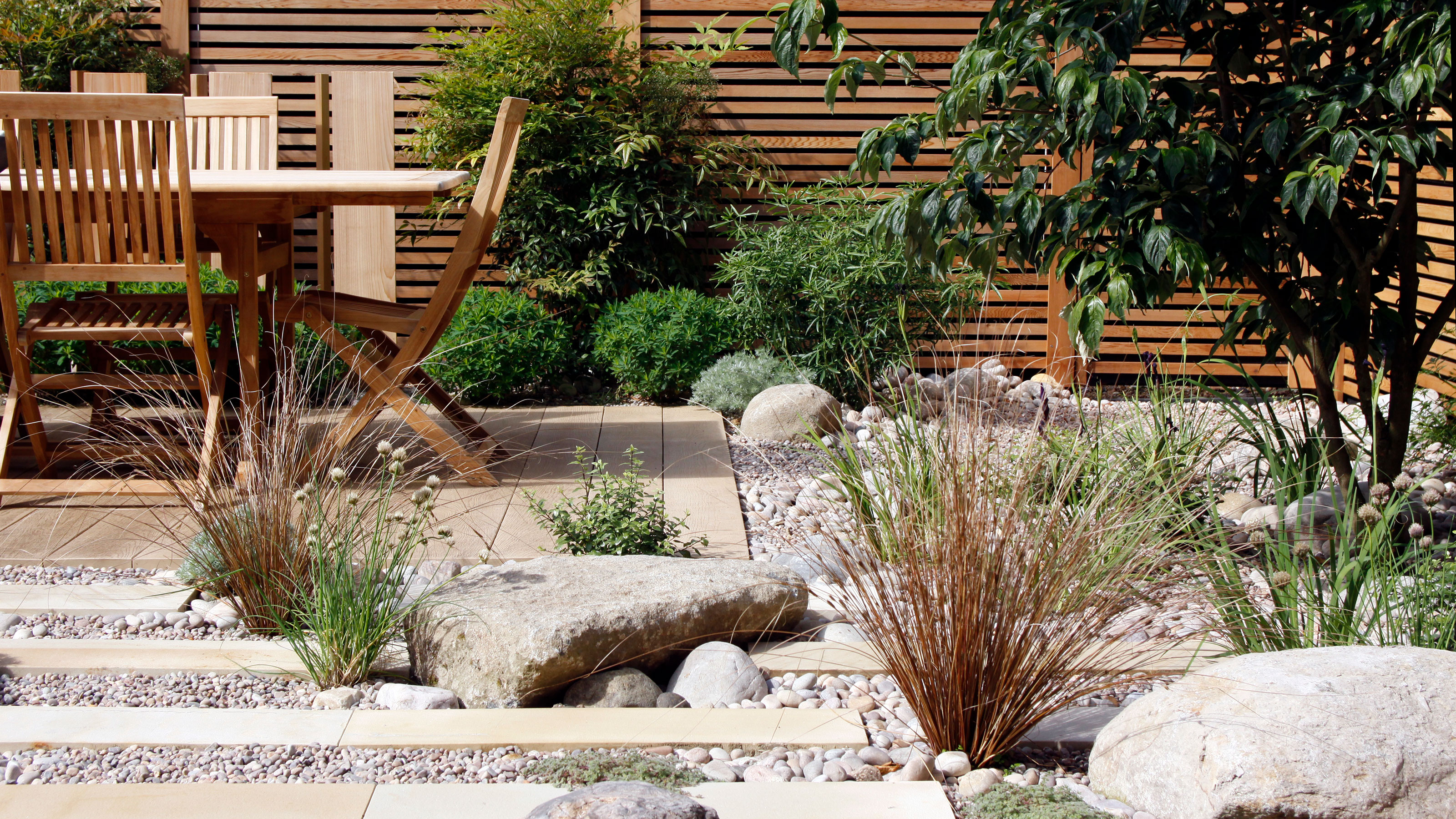

If you want to add a natural feature to your plot, landscaping with boulders will transform your outside space with a bold new look. From calm Zen-inspired designs to practical retaining borders and large stone monoliths, there are plenty of clever ways to introduce a breath-taking sense of scale and form.
It may seem radical to transport a large rocky boulder into your yard or work an entire garden design around one that’s already in place, but mankind has long had a fascination and reverence for these natural blocks so it’s certainly nothing new.
Weathered by elements over centuries, each leaving their own unique marks on the surface and revealing the minerals within, it’s easy to be captivated by their texture and beauty. These giant rocks have also been a focus for quiet contemplation, with the Japanese forming extensive dry gardens of fine gravel punctuated by rocky outcrops.
The perfect foil for foliage, blooms and other natural materials, stone – whether it’s golden sandstone, sparkling grey granite or deep green-grey slate – can be surprisingly colorful, particularly when wet. Choose to highlight it at night with garden lighting and you can enjoy a spectacular focal point in your landscaping ideas, whatever the time of day or night.
Try landscaping with boulders for a striking backyard scheme
There are plenty of different and stylish ways to incorporate ideas for landscaping with boulders into your outside space, but there are a few tips to follow.
‘Study how boulders work in the wild,' says Rick Everett, of landscaping design company Kirman Design. 'Flatter or smaller stones tend to be at the front with the larger ones at the back. If there are trees or plants, then the boulders need to work in height order with those too.’
Our selection of ideas, tips and tricks will help you incorporate these stunning stone additions into your plot, whether you're using them for your front yard landscaping or a backyard redesign.
1. Squeeze alpines in amongst the boulders
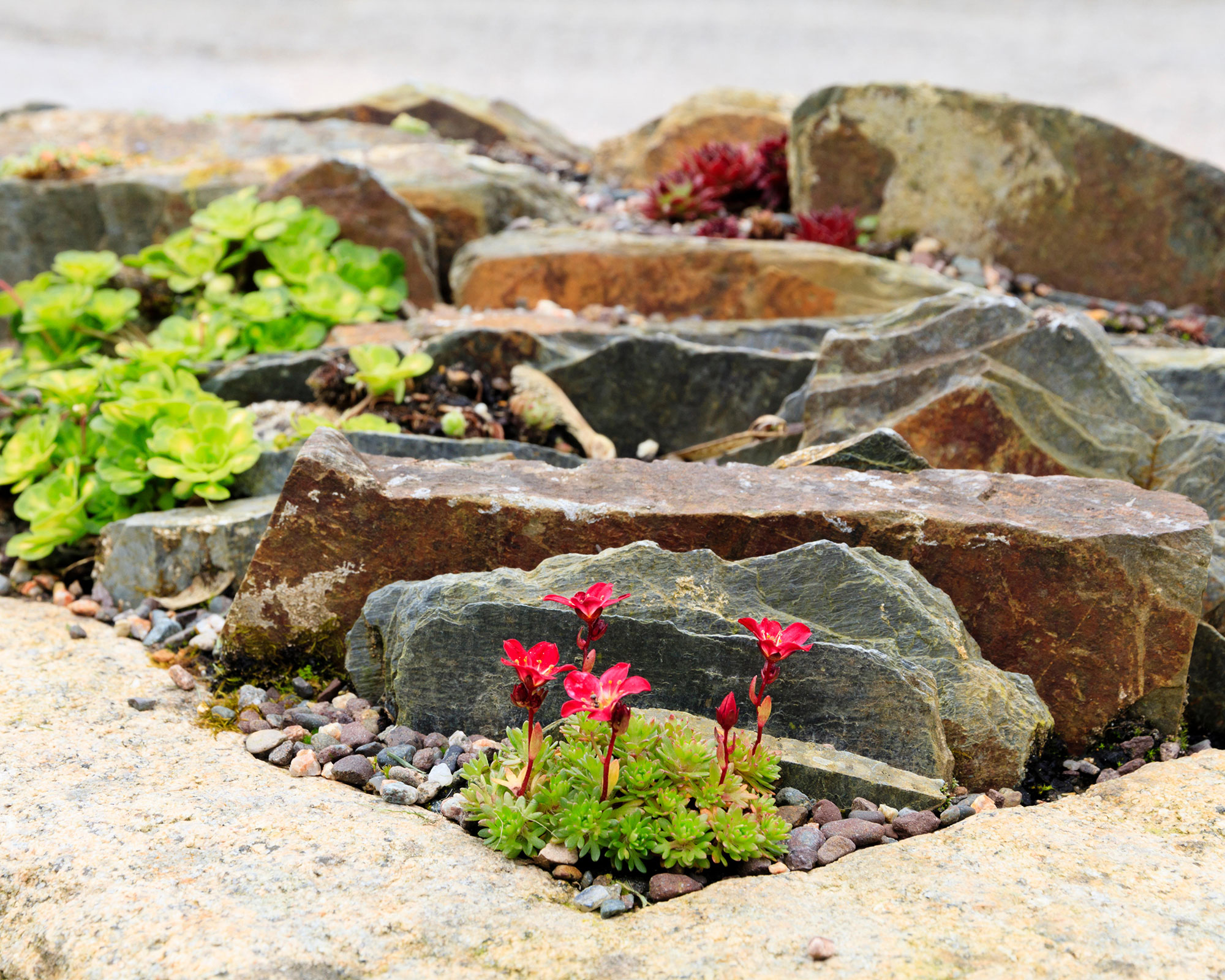
Tuck plants in between boulders to soften the hard landscaping
Although this is more of a modern rock garden, there’s something irresistible about miniature plants blooming happily tucked in between giant, craggy rocks. Whether it’s the delicate contrast of the leaves or the jewel-like glimmer of their flowers it’s a sight that never ceases to impress.
The beauty of landscaping with rocks to create a flowering boulder garden is that you can vary the scale to suit your space. A large, low container packed with rocks and interplanted is just as intriguing as a majestic rocky slope.
Tough little plants, alpines will cheerfully tolerate cold, exposed locations just as long as they have their roots in gritty, free-draining soil. For maximum interest, go for a variation of plant heights and leaf size and aim for plants that successively flower throughout the year.
2. Strike a contrast with textured stone
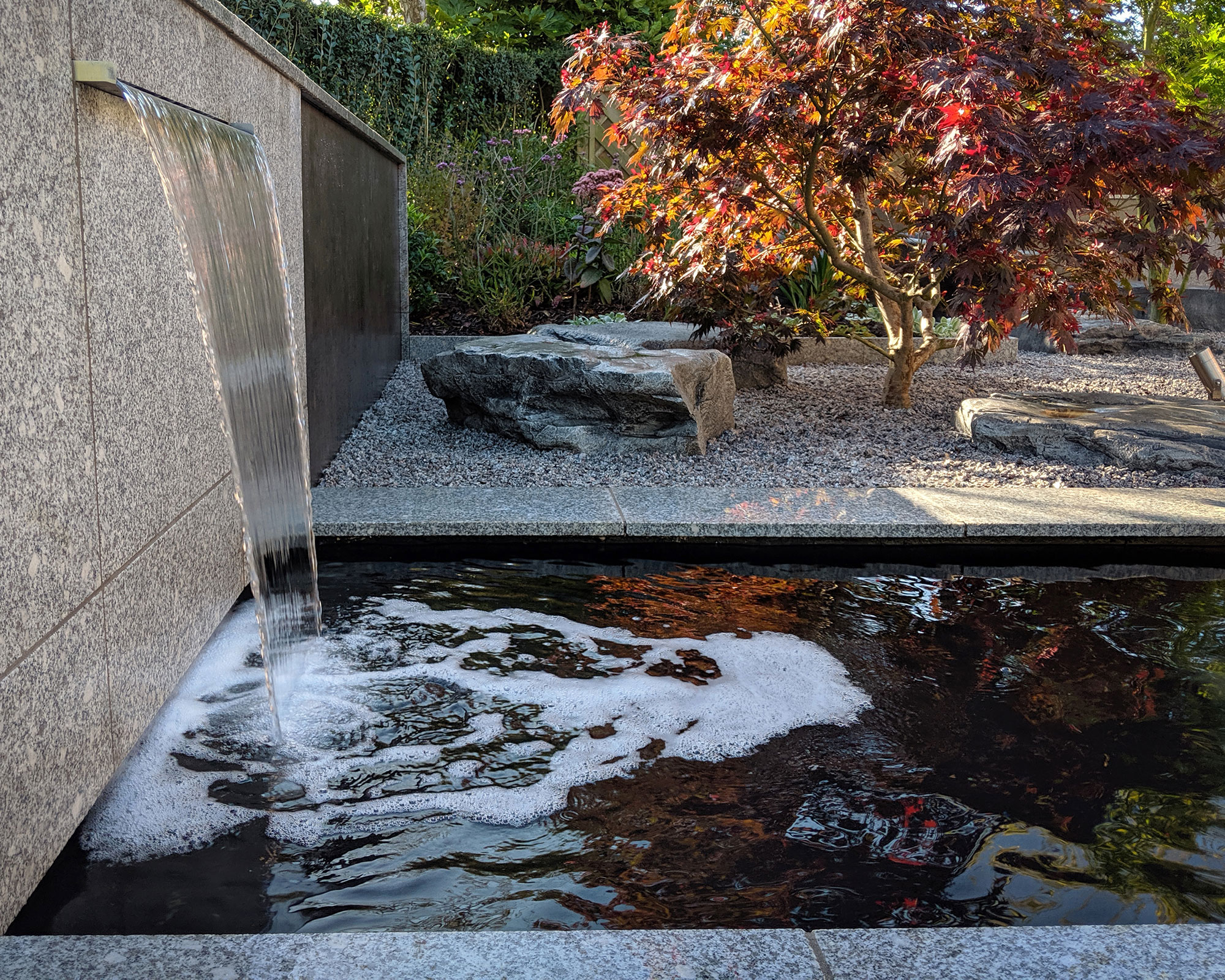
Less is more in this stunning Japanese-inspired redesign by Kirman Design
Making bold choices in a contemporary garden is key. Just a few large features, careful placement and planting selections all beautifully executed is what allows these simple materials to shine and brings the space alive. Stone boulders are no exception. Craggy and creviced and complete with jagged, uneven edges they ooze robust nature. Team them with fine toning gravel and composite polished stone tiles and they create a fascinating tension, as shown in this standout contemporary garden pond design by Kirman Design.
Contemporary Japanese garden ideas follow the same design principles as traditional ones, with clean, sharp and minimality compared to their traditional counterparts. The goal is to use the same stone or at least color palette as other hard landscaping materials in your design.
‘Stones need to be chosen to work in groups of various sizes; large medium and small; repeated, if necessary, in 3, 5, 7 or 9s,' says Rick Everett of Kirman Design. 'Take the time to study how and why ornaments, rocks and plants are traditionally positioned in original Japanese gardens, as a successful arrangement hinges on authenticity.’
3. Draw shapes with boulders
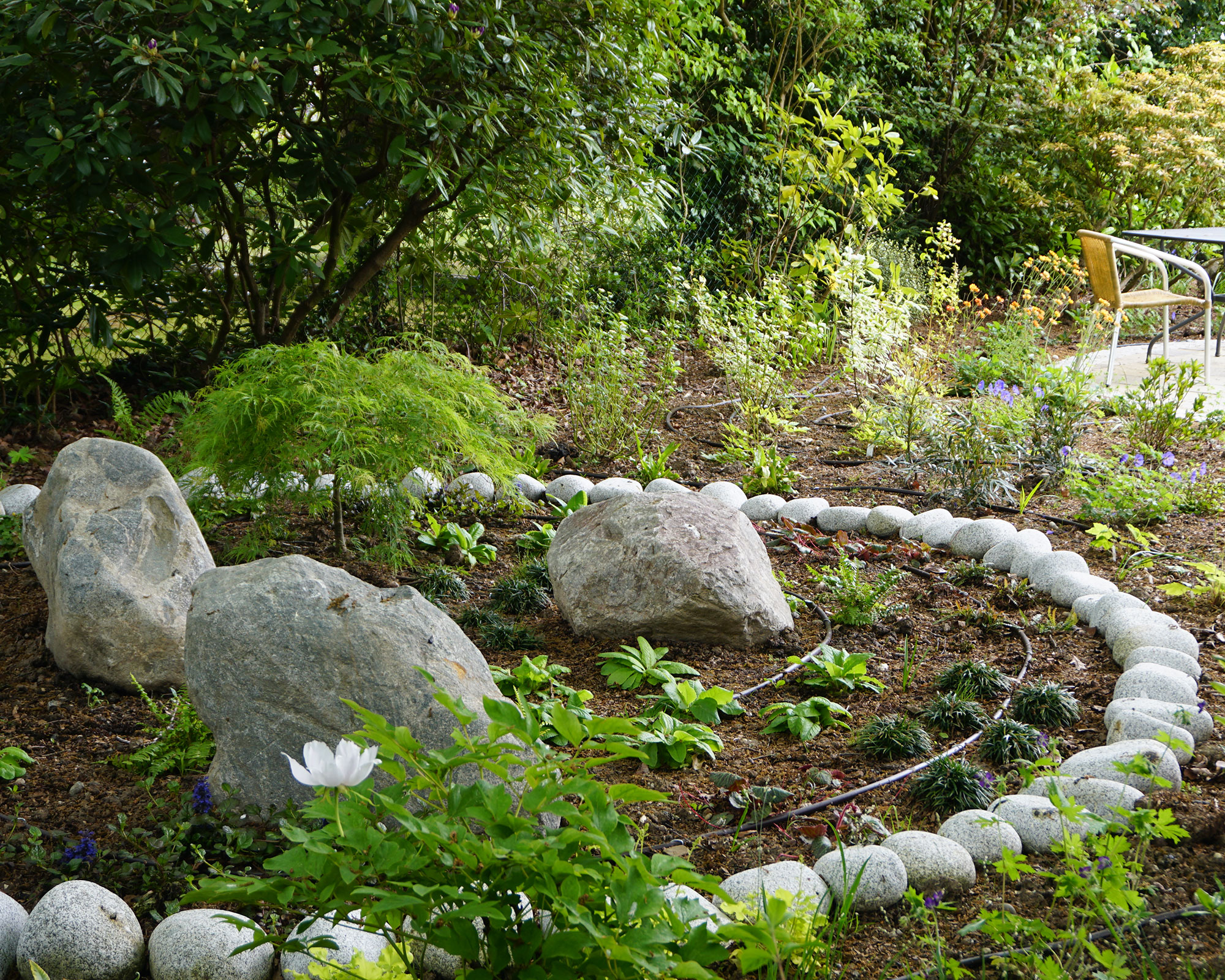
Highlight an area under trees with a stone circle, as in this project by Fenton Roberts
There’s something rather magical about coming across a stone circle or spiral within a garden. Deliberately made but curious and intriguing, it draws you in and invites you to explore the location and the surrounding plants. The stones themselves lend something of a timeless quality to the overall design, remaining there throughout the seasons, year in year out while the plants and flowers around them grow and fade.
Take a look at your plot and assess potential sites for your boulders. It could be a clearing where you can introduce them as innovative landscaping around trees, a grassy spot overlooking a view or even an area within a patio.
In this project by Fenton Roberts, ‘the boulders and surrounding cobble circle are intended to bring focus and order into what would otherwise be a large area of planting in difficult growing conditions beneath mature oak trees,’ explains designer Jo Fenton.
‘The garden was newly planted when the photograph was taken but the intention was that the low ground cover plants within the cobble circle will spread out to create a patchwork of green surrounding the Acer tree, which will also grow much larger. Outside the circle we created a contrast by planting a variety of much taller flowering shrubs and perennials. Once matured the circle area will become a calm, meditative space nestled within the wider planting.’
4. Try a trio of stone monoliths
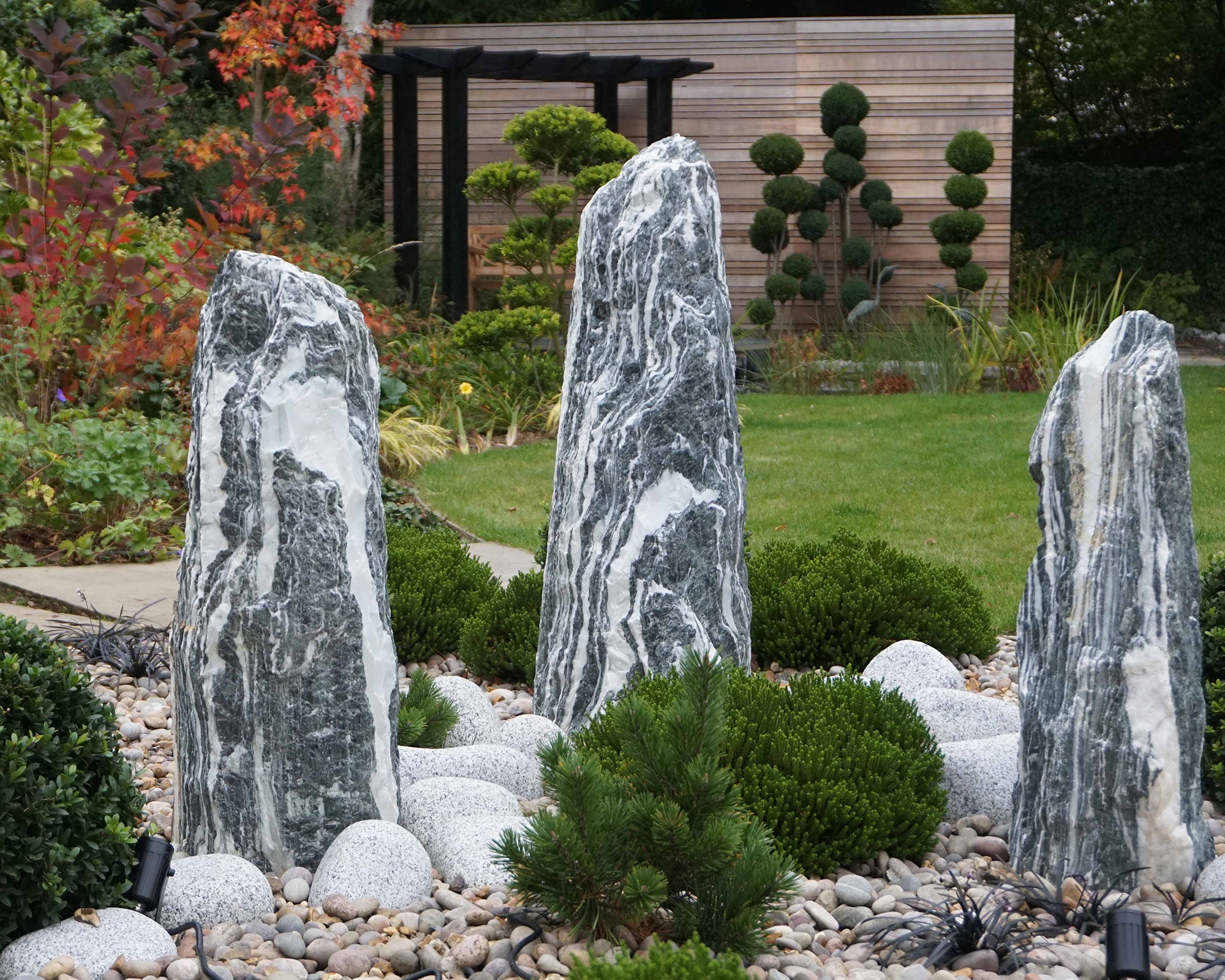
These Angel Standing Stones are from CED Stone and have striking bands of white marble rippling through the dark grey green stone. Project by Fenton Roberts
Whatever the weather – rain or shine – a trio of standing stones will capture your attention and radiate a feeling of calm. The perfect low maintenance landscaping idea, position them where they can be seen from the house, patio or at the end of a pathway and marvel at the way their appearance changes throughout the season and at different times of day. The secret to making them work is to ‘bed’ them into the overall style and feel of the garden.
‘The client wanted a garden which would remind them of holidays in Japan,' says garden designer Jo Fenton. 'We didn't want to replicate a Japanese garden but the standing stone area is a nod towards the Japanese rock garden. We mainly created the Japanese feel by using appropriate plants throughout the garden. In the more formal space surrounding the stones this meant using low growing, mounding, evergreen shrubs.’
5. Embed boulders into patios and pavers

Add large boulders to the edge of a patio for a modern style. Landscaping by Greencube Design
Careful placement of boulders and stones in and around your patio is a great way to give your outside space a natural and restful feel. Rather than moving suddenly from rock garden to paved patio, a gradual transition will not only make the space appear more cohesive and designed but it can help it feel bigger too.
Intermingling contemporary plank paving ideas with shingle, cobbles and boulders not only creates a fascinating play of textures but helps to blur boundaries between planting and functional paved areas.
‘Boulders and a mix of Scottish pebbles of various sizes add a natural sculptural look and structure in this small garden,' says Amanda Buckland, garden and landscape designer from Greencube Design. 'They are used as stepping stones within this courtyard garden. Don’t make the mistake of plonking them on surface, we bury 30% to make it look natural, like an outcrop.'
Low growing, tough grasses and low maintenance ground cover plants add height to the landscaping and need very little attention, year-round.
6. Incorporate boulders as impromptu seats and perches
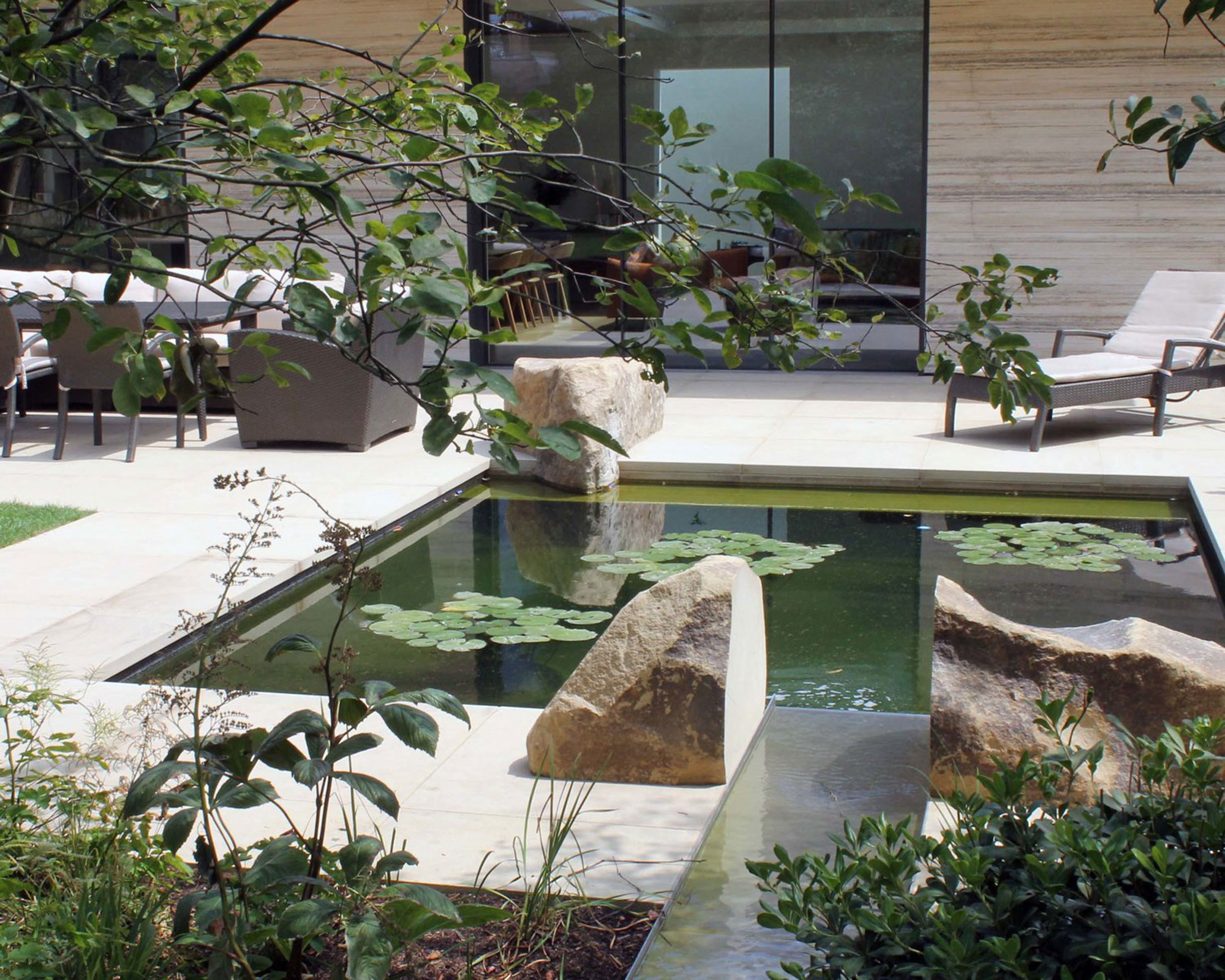
In this project by McWilliam Studio, the boulders double up as informal seating
Besides making a striking design statement, introducing landscaping with boulders into a hard landscaping design can be practical too. Doubling as handy side tables, casual seating, diving plinths and even play spaces, they can help shape the way the outside space is used.
‘Boulders run throughout this scheme to provide informal seats, diving plinths and sculptural forms integrating with the proposed planting,' says Gavin McWilliam from McWilliam Studio. 'Crosland Hill stone was used for both the terraces and the boulders. These were hand-picked and sawn to shape before being shipped to site and installed using a spider crane and some masterful scribing by the team.’
7. Showcase a boulder with planting
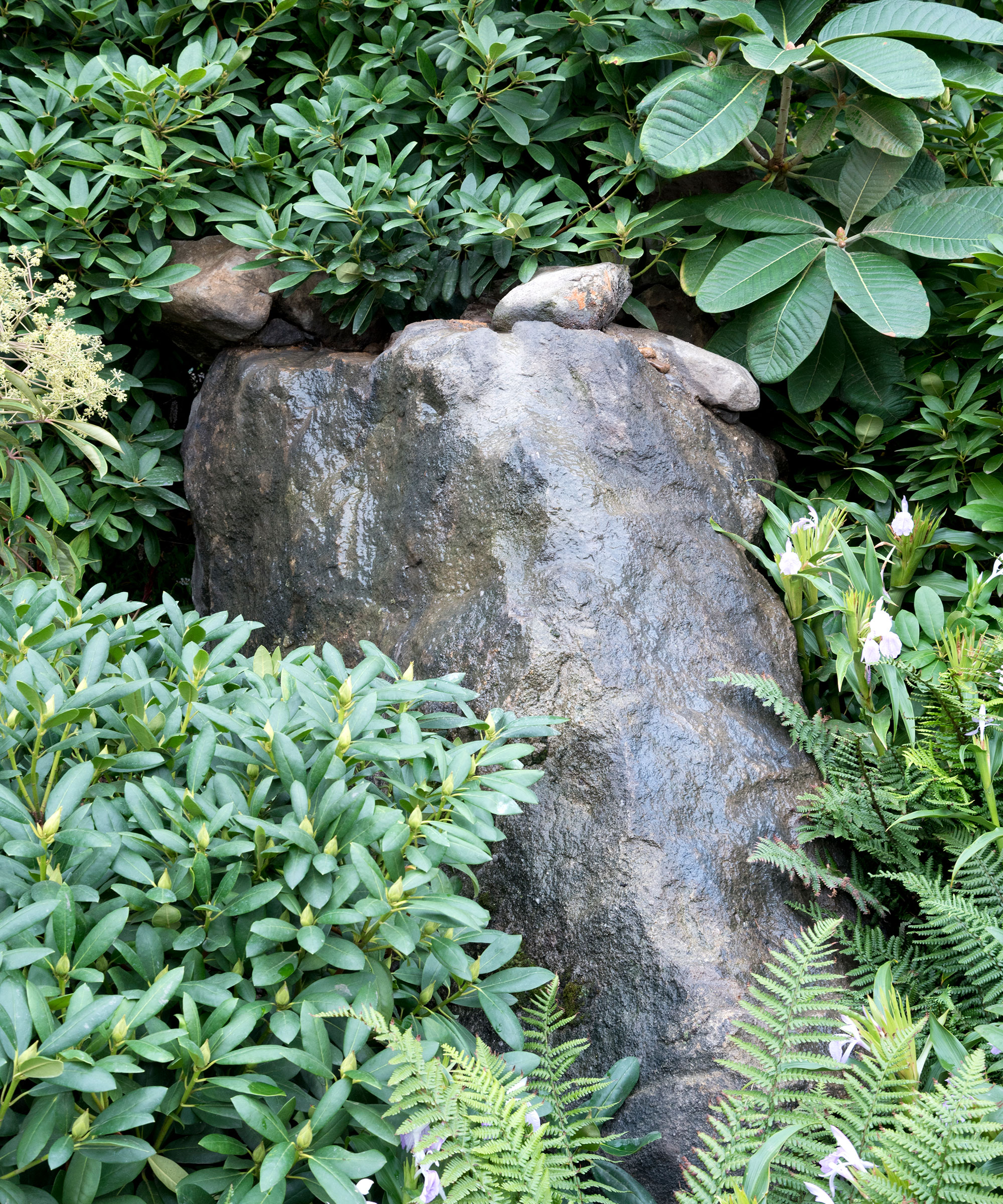
Surround a boulder with planting to help it blend into the landscape
Landscaping with boulders can allow you to create a striking focal point in your plot for a truly individual and stunning result.
Choose a stone with interesting markings, fissures or profile and display it proudly. Whether it's at the centre of a courtyard or clearing or tucked away at the edge of your plot, it will add a dramatic touch to your garden design.
Use planting to create a simple background to highlight the boulder’s unique shape and character. Landscaping with shrubs – such as dense evergreen varieties like boxwood, yew or hedge germander – will work well thanks to their mass of small dark green leaves.
Alternatively echo the shape of your star feature elsewhere in the garden. Clip shrubs into similar shapes or choose small trees with a similar foliage or bark color.
8. Retain garden borders with boulders
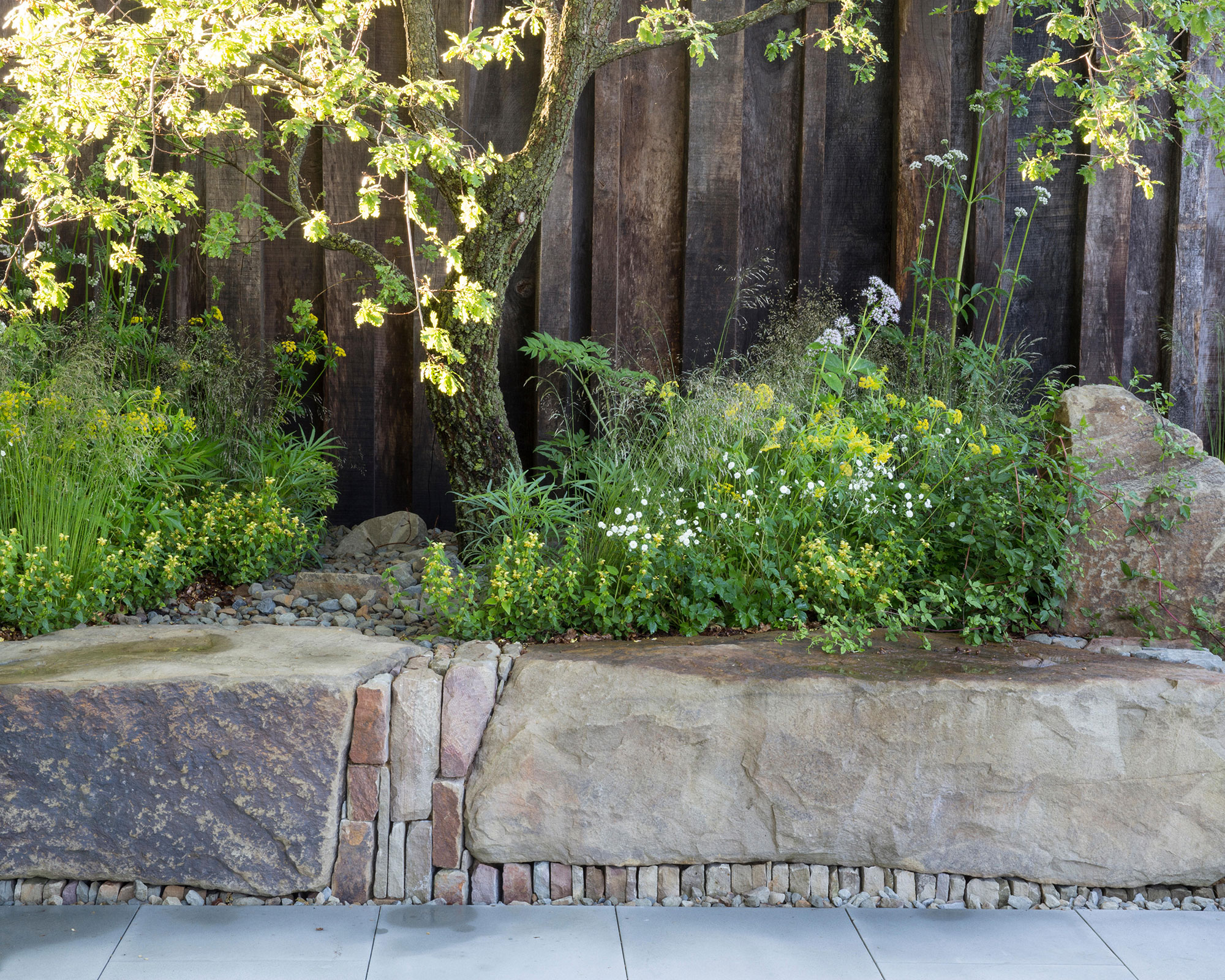
Large boulders can be used as stylish edging for beds and borders
If you're lucky enough to have some flattish boulders in your yard, then use them as garden edging ideas to hold back the soil and create a planting area behind. Perfect for sloping gardens or smaller plots, they will lend a natural yet structured feel to a smaller garden and work well alongside other raw materials such as wooden fencing and sawn stone paving.
Choose whether to simply place the blocks end to end along the border, and let plants spill between them on to the garden path, or to pack them in with smaller sections of rock to form a more uniform and even edging.
Natural heat retainers, boulders will also help to warm up the soil in the garden border behind them, encouraging strong, healthy plants to thrive.
Add plenty of gravel or slate into the soil and you have the ideal conditions for landscaping with flowers including sun-loving herbs and Mediterranean plants such as flowering thyme, rosemary, lavender, and fennel. Dress any bare soil with more shingle to suppress weeds, retain moisture and for a neat, professional finish.
9. Show off boulders with garden lighting
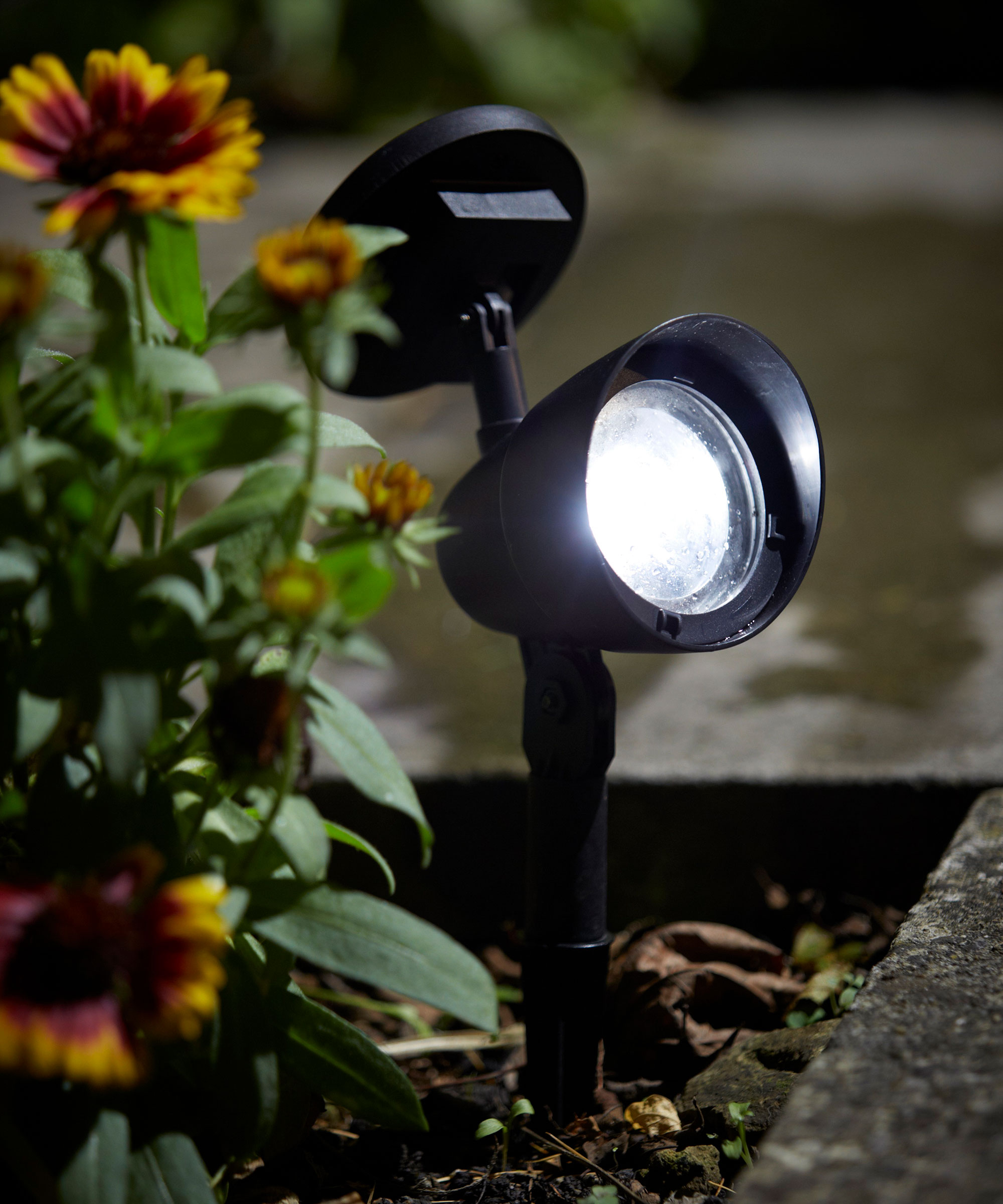
LED solar spotlight from Gardenesque
Not just daytime features, boulders can become magical at night. Experiment by landscaping with lights using low voltage or solar spotlights and uplighters to either highlight the rugged texture and craggy shape or to use the stone’s surface as a screen for shadow play.
Sinking a simple spotlight into the ground and angling it so it shines through foliage to cast an intriguing silhouette onto the stone, creates a simple but fascinating effect when landscaping with boulders. Enhance the result further by going for two or three lights placed around the boulder to emphasize the different sides of the boulder and its sheer size.
Finely cut fern fronds, swaying grasses and the heart-shaped leaves of epimediums all cast intricate shadows. Play with the positioning of your outdoor lighting ideas too, moving lights closer or further away from the plant to sharpen or soften the detail. Cool and warm white LED lights plus those that change color provide scope for even more variation.
10. Make an impact with stone-filled gabions
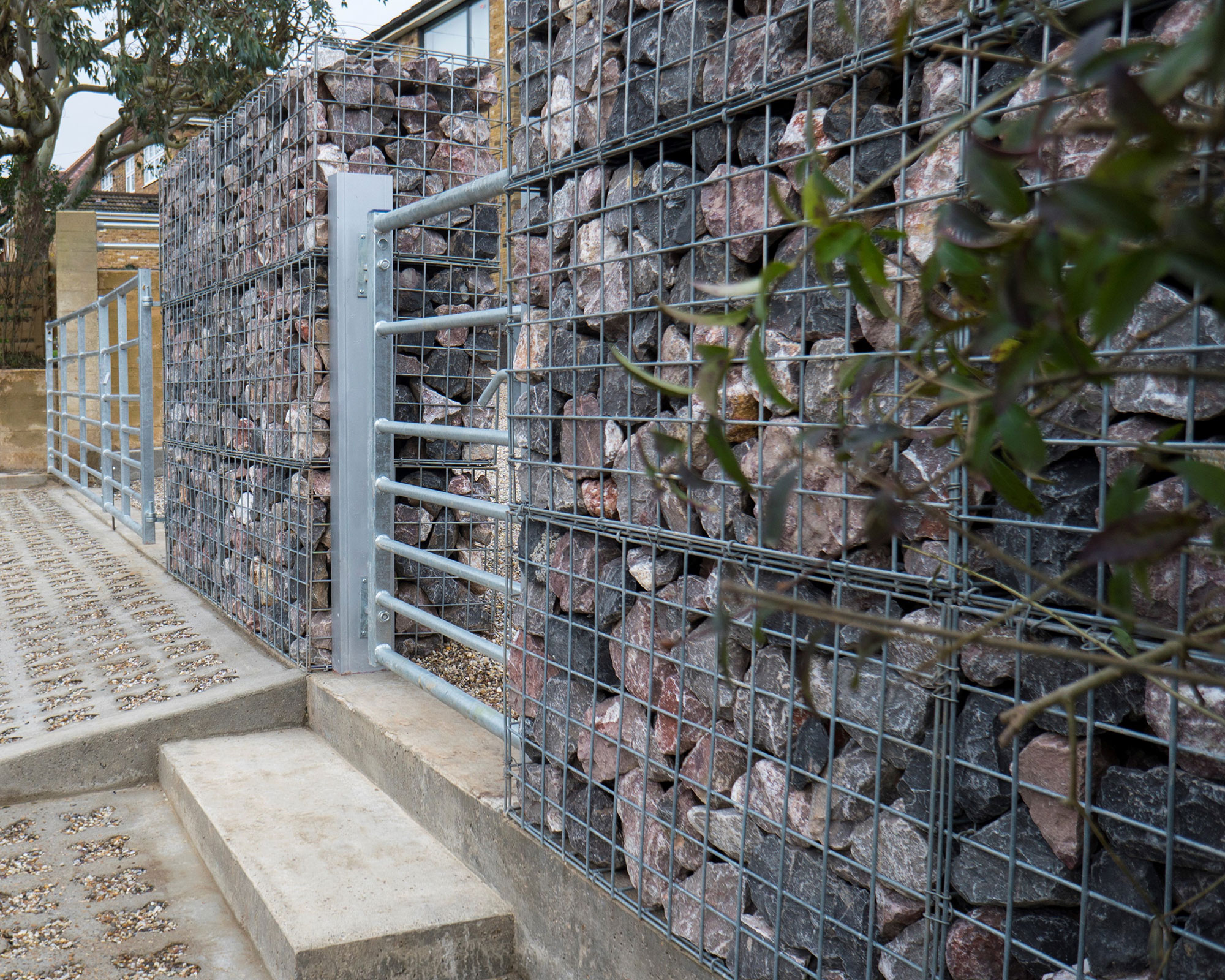
Use boulders to create a striking entrance, as in this project by Karl Harrison
Galvanised wire gabions filled with red tinged Bayfield stone create a robust and textured wall, peppered with varying shades of red, plum and rust. Cost effective and perfect as a standalone or retaining wall, gabions can be filled with a rocks and boulders of any shape or size and even planted up with succulents and creepers for variation.
Brilliant for reinforcing slopes and terraces, they also let rainwater drain through, which is hugely important particularly in exposed or heavily built-up areas or climates prone to tropical downpours.
Locally quarried stone is always the most cost effective as it’s usually readily available and cheaper to transport, but if you're in need of cheap landscaping ideas and really want to keep material costs down, then why not fill the centre of each gabion basket with bricks, hardcore or broken paving and use your selected stone to clad the visible sides and top.
'There’s nothing to hide behind in this scheme,' says designer Karl Harrison. ‘The materials, like the property architecture, has a raw synergy which in the most basic form was stripped back and laid bare. The combination of the rocks, steel, raw timber and concrete in the most basic form works as a message of function over sympathetic design.’
How do you landscape around a large boulder?
- Integrate the boulder into its surrounding by planting textured ground cover plants around a third or two thirds of the base. Carex, heuchera and black mondo grass all work well.
- A small acer or Japanese maple sits beautifully alongside a larger boulder. Evocative of Zen gardens, it will radiate serenity and tranquillity all year round.
- If your spot is shady or the cast boulder casts deep shadow, opt for a mix of ferns such as glossy Hart’s Tongue and bronze-pink Japanese painted fern for a lush, woodland feel.
- Surrounding the base of a boulder with toning garden gravel ideas and a few smaller rocks will create a sense of scale and visually link it into the rest of the landscaping.
- Landscaping with grasses can also be a beautiful way to soften the effect of large boulders, helping them to blend into the surrounding foliage.
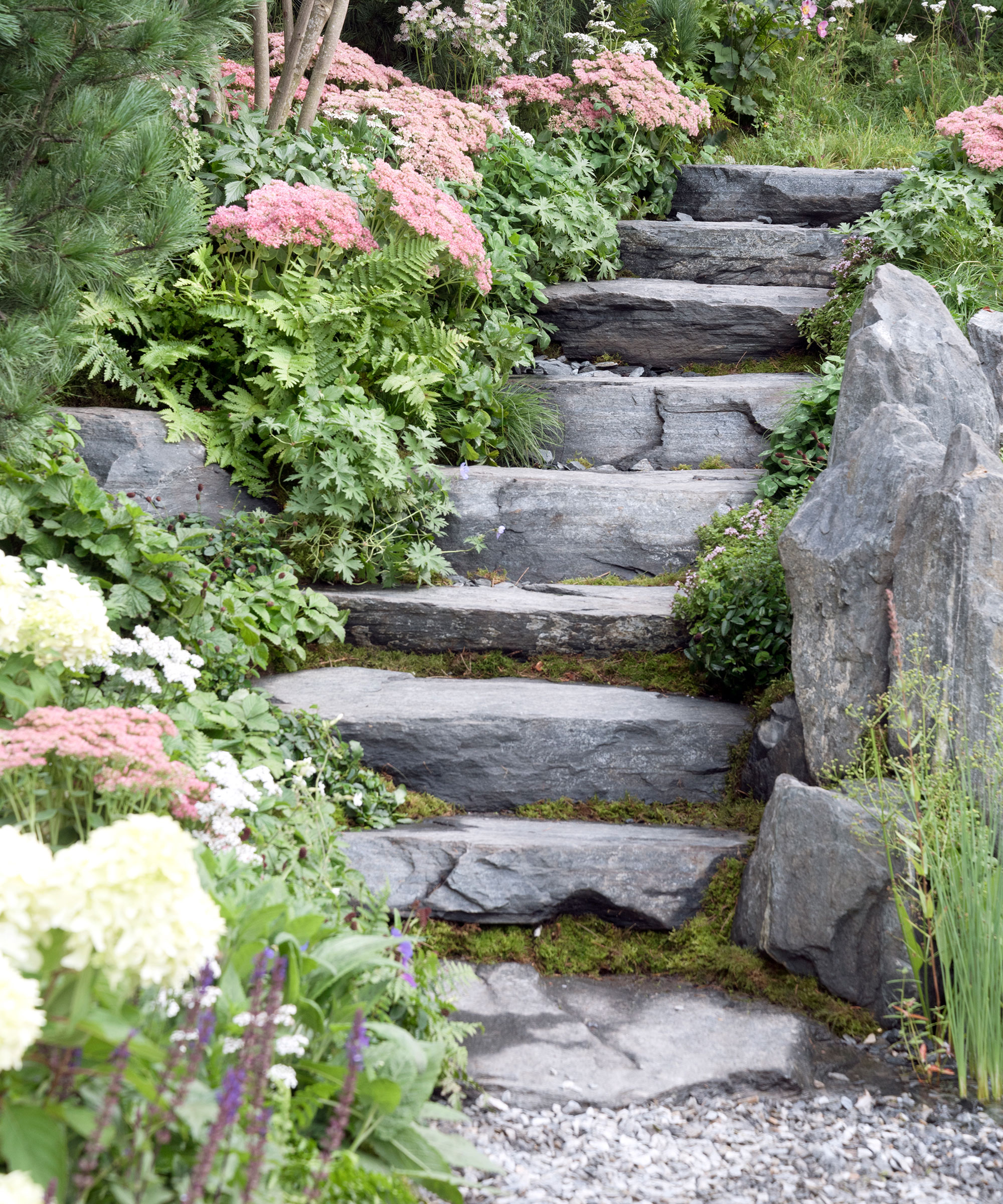
How do you use boulders in landscaping?
‘Natural stone boulders can create beautiful focal points within your garden or outdoor space. When positioning your boulders, think about burying a small portion of the stone base beneath the ground to make them look grown in and natural,’ suggest the team at CED Stone.
‘Natural stone transforms when wet, and this is no exception with boulders. Make sure you look at how the boulders will change in the rain or underwater fountains and assess whether this will still work with your chosen garden color scheme. No two boulders are ever the same, so we suggest that you take your time to pick one that's the right size, shape and color for your scheme.’
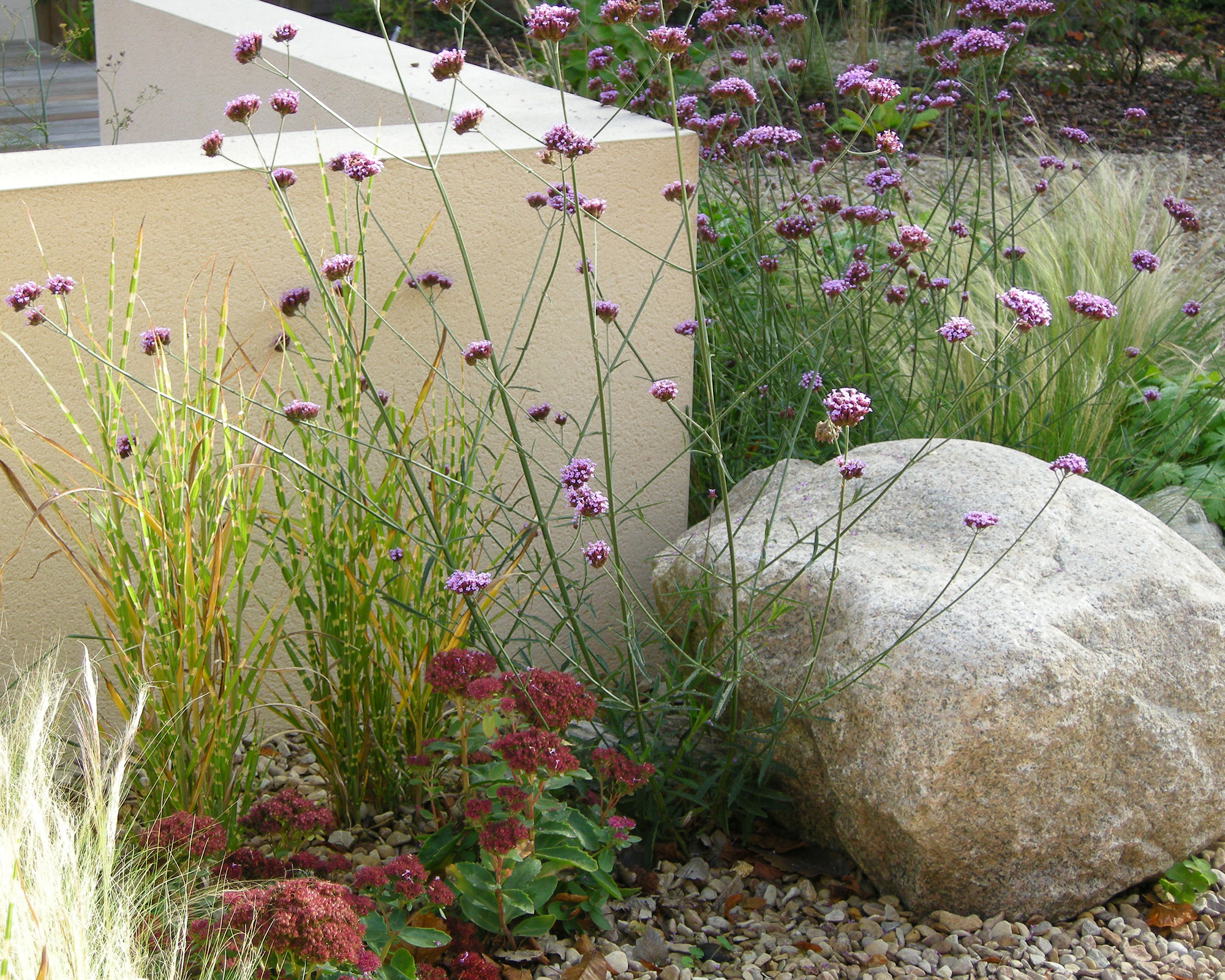

Jill puts her love of plants and all things garden related down to the hours spent pottering around with her Nan and Grandad when she was little. Today she is lucky enough to have a garden of her own in Surrey, England, and spends much of her time writing about them too.
